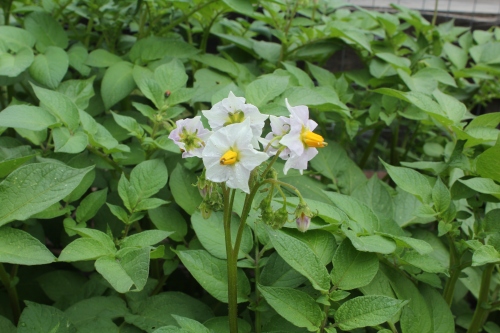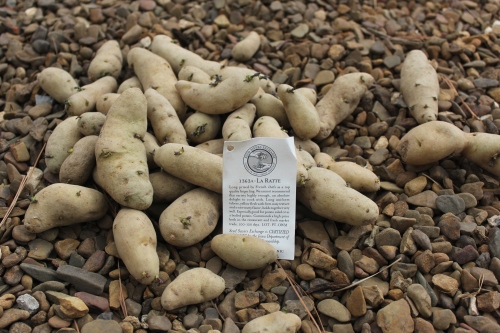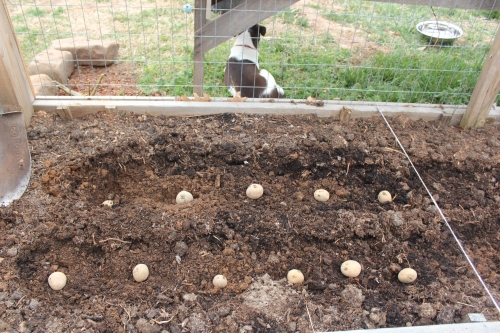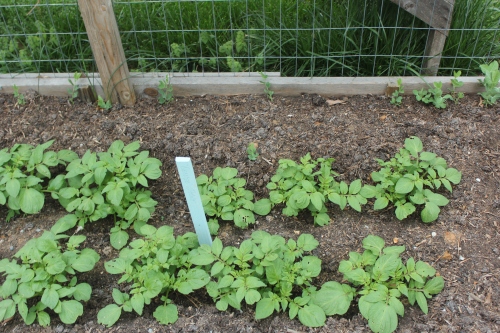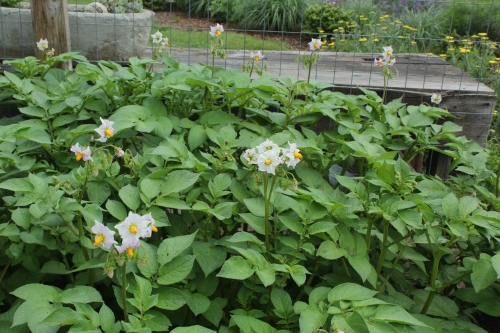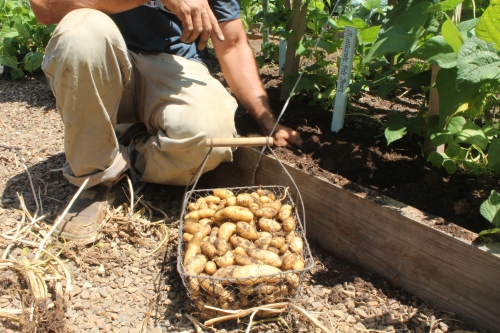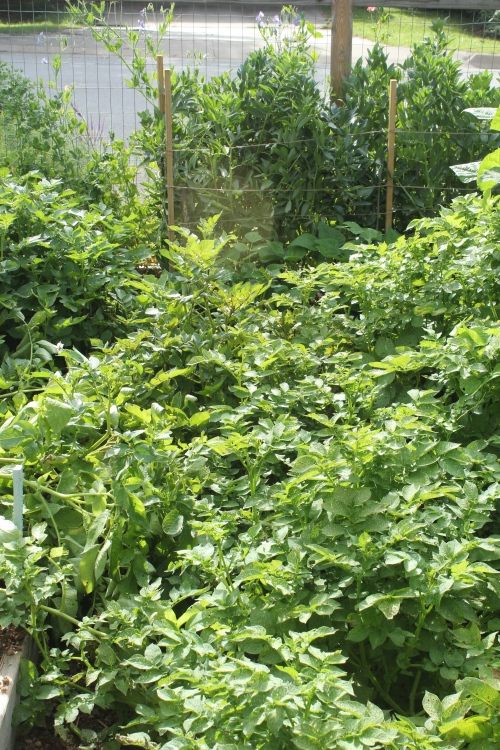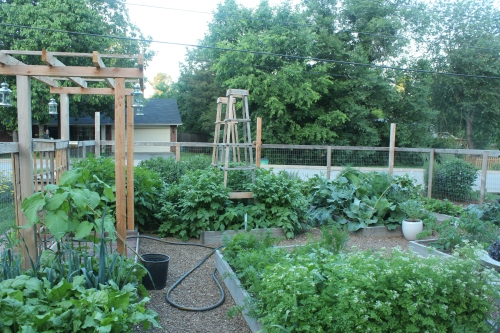If you need to be reminded of the earth’s ability to create abundance, place a seed potato in the ground in April. By June, when their beguiling flowers begin to blossom, you can reach into the earth and bring up nothing short of buried treasure. The taste of those first homegrown new potatoes, with their delicate feathery skin, is a revelation.
Potatoes are one of the largest food crops in the world, right up there with wheat, corn, rice, and sugar cane, and they produce one of the highest yields per area planted of all food crops. They are low in calories, have no fat, sodium, or cholesterol, and are full of potassium, Vitamin C, Vitamin B6, fiber, and iron. And for all that they have still ridden the wave of fashion throughout our history with them. Yet as historian William H. McNeill, argues in his 1999 article, How the Potato Changed the World’s History, the humble potato created at least two empires and changed the world in a number of ways.
Potatoes originated in the Andes Mountains of Peru, the longest continental mountain range in the world, a whopping 4,500 mile spine of seismic activity and extreme temperature fluctuations that stretches down the western coast of South America. Wild potatoes are full of toxins to protect them from predators both microscopic and macroscopic, but the ancient Incas (Empire #1) cultivated them in this much less than hospitable place, breeding them to be less-toxic and developing thousands of varieties for the multitudes of growing conditions with which they were faced. The International Potato Center in Peru contains almost 5,000 varieties!
Spanish conquistadors arrived in the region in 1532 and following the natives lead, began to eat the strange food, taking some with them when they departed. By 1570 the potato had arrived in Spain, and while a few farmers began to grow them, most were consumed by livestock. It took quite a while, but slowly they began to spread to the rest of Europe.
By 1596 the potato had at least been given its name, Solanum tuberosum, by the Swiss naturalist Gaspard Bauhin. Still, early reception to this new food was unenthusiastic. It was feared for its resemblance to other plants in the nightshade family, thought to cause leprosy, reviled by believers because it wasn’t mentioned in the Bible, and generally ignored because it was considered ugly and tasteless and because it came from a heathen continent (ours) – it was a food only fit for animals.
Frederick the Great of Prussia famously tricked his people into eating potatoes during a famine there in 1744 by placing guards around his potato field. The peasantry deduced that whatever was worth guarding in there was worth eating, and when the fields were (intentionally) unprotected, they sneaked in, stole the plants, and put them in their own gardens.
In France, the potato’s PR hero was Antoine-Augustin Parmentier. As an army pharmacist during the Seven Years’ War (1756-63) he was imprisoned five times, subsisting on little but potatoes. After the war he became a nutritional chemist and devoted his life to championing the potato. Due to his efforts, the potato was finally declared edible by the Paris Faculty of Medicine in 1772. So if you see a recipe with the word Parmentier in the title, you can rest assured that the dish features potatoes. The story goes that when Parmentier was on his quest to raise potato awareness he had a big society party featuring a variety of dishes made with potatoes. He presented Marie Antoinette with a bouquet of the flowers which she wore in her hair, causing a fashion moment. Thomas Jefferson, who was also a guest at the party, reportedly served potatoes “in the french manner” at a White House dinner upon his return.
This reluctance to embrace the potato is incredibly ironic considering that poverty and famine were commonplace throughout Europe before the shift to potato cultivation, especially in the countryside. Then, wherever it traveled, populations exploded. France had hovered on the brink of starvation, experiencing a nationwide famine approximately once a decade from 1500-1800, before the potato arrived. In Ireland between 1780-1841 the population doubled to 8 million, and this without any change in industry or agriculture, beyond adoption of the potato. According to conservative estimates, the introduction of the potato was responsible for a quarter of the growth in Old World population and urbanization between 1700 and 1900. (Empire #2.)
Unfortunately, by the early 1840’s many of Europe’s poor, especially those in Ireland, were existing on nothing but potatoes, so when that monoculture was plagued by the pathogen Phytophthora infestans the results were devastating. An estimated 1,000,000 people in Ireland died during The Irish Potato Famine ( 1845-52) and twice that fled the country, many of them to the United States.
Another potato pest gave rise to the modern pesticide industry. Leptinotarsa decemlineata, the Colorado potato beetle, was first discovered in the United States in the 1824. It is believed to have come from Mexico where it fed on the potato relative, buffalo bur (Solanum rostratum). By the 1840’s it had arrived in the United States where it discovered and laid to waste acre after acre of domestic potatoes. Desperate farmers tried everything in their arsenal to destroy them, but it wasn’t until one hopeless farmer threw some old green paint on his plants that anything worked. That paint, Paris green, turned out to have been made with arsenic. Various arsenic compounds worked for a while until the beetles developed resistance to them. Enterprising chemists began to try any number of chemical brews, which all worked, for a while. By the end of WWII, the answer was DDT, that lasted about seven years. After that it was deildrin. You don’t even want to know about dieldrin.
Now do you want to grow your own delicious organic potatoes? I sure do.
Luckily that’s an easy thing to do. As Deborah Madison so nicely puts it in her masterwork, Vegetable Literacy (2013) “potatoes are obliging in the garden,” as anyone who has ever thrown one on a compost pile can attest. They want to grow.
Plan on planting them 2-3 weeks before the last frost date in your area. The last frost date I use for my area is April 20th. (That doesn’t mean it’s not going to snow in May.) We planted ours on March 30th.
Unlike most garden crops, potatoes are not grown from seed. Instead they are grown vegetatively from small potatoes called seed potatoes.
Seed potatoes can be planted whole or cut into pieces, as long as each piece has an eye. I plant mine whole because I have more potatoes than I have room, but if you do cut yours, use a sharp knife and allow them to callus overnight. Potatoes are heavy feeders, so I worked plenty of compost into my soil while I was loosening the soil in preparation for planting.
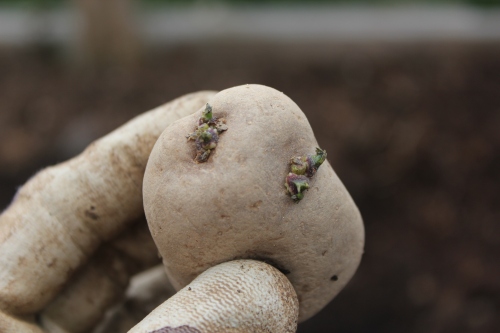
Traditionally potatoes are planted in a trench about 6″ deep and they are placed 12-16″ apart. We made two trenches about about 18″ apart. Further apart would be better, but our garden is on the small size, so we plant pretty intensively.
Each trench is then re-filled with soil. Soon, from each of those eyes a sprout will develop. Miraculously, that sprout will find the sun and begin to make leaves above ground.
Then, from the stem of that sprout will come stolons, the ends of which will swell to create potatoes. For this reason it is important to do what is called hilling up. When the plants are about 4-6″ tall, cover then with loose soil almost to the top of the leaves. Plan to do this again about three weeks later. This year I’m going to try my second hilling with pine straw. I’m also going to try to grow some in a container, which is a great option if you don’t have an in-ground garden. I’m going to put about 6″ of soil in a big (30g) plastic nursery pot, I’ll space about 5 potatoes in it and cover them with 4-6″ of soil. As they grow, I’ll continue to hill them up until the soil in the container is 18-24″ deep.
Seed potatoes can be kept back from the previous year’s crop, or ordered fresh every year. I ordered mine from Seed Savers Exchange (http://www.seedsavers.org).
Because they are grown vegetatively, each potato is a clone of its seed potato, which means that diseases are passed down along with other genetic characteristics. Therefore, the oldest heirloom varieties that we grow today were developed after the blight, around the 1850’s, from Mexican or South American stock.
This year I’m growing La Ratte again, it’s a French fingerling with a delicious nutty taste. I grew them last year because Seed Savers “couldn’t recommend them highly enough.” Roasted whole with olive oil and sea salt, we enthusiastically concur. We didn’t save a single one to store or use as seed, but I’ll try harder this year. I’m also trying Yellow Finn, whose “exceptional buttery sweet flavor sets it apart from all other potatoes.” I’ll let you know.
In about 60 days, those beautiful flowers will appear, (although sometimes they don’t and the plants still produce potatoes).
Tuck one behind your ear à la Marie Antoinette, then patiently wait for a couple of weeks. When you can’t stand it any longer, gently dig into the soil around the stem, where hopefully you’ll find your buried treasure. These are what are called new potatoes and they are an early summer luxury.
You can pull up the whole plant, eat them all immediately, and grow something else there, or you could continue to harvest throughout the summer. Be warned, they take up a lot of space.
That’s a path.
Here’s the potato corner June 1, 2014. Sorry beans.
By fall, the foliage will begin to die back. You can leave the potatoes in the ground for several weeks, but make sure you harvest them before any killing frost, or if the weather is warm and wet and could signal the potatoes to start sprouting. I don’t have the greatest conditions for storing potatoes, which is just as well, because once I start harvesting them I really can’t stop.
For a great article comparing different potato planting methods, check out (http://www.rodalesorganiclife.com/garden/7-ways-plant-potatoes).

